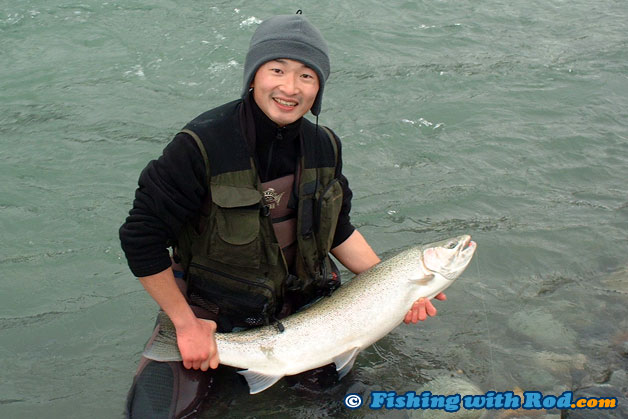Steelhead Hatchery Program, a Success Story!
By Chris Gadsden, Fraser Valley Salmon Society | Published in April 2003

Thanks to the dedicated staff from the Fisheries and Oceans Canada, Chilliwack River Hatchery, and the Provincial run Fraser Valley Trout Hatchery, the Chilliwack/Vedder River has one of the best steelhead opportunities anywhere. It is the cooperation between the Chilliwack River Hatchery, managed by Bob Stanton, and the Abbotsford situated Trout Hatchery, run under the direction of manager Dale Larson, that is a unique situation in itself. The two seperate Government agencies have work very well together to provide hatchery steelhead as well as protecting the wild stock at the same time.
Larson and his fish culturists along with Stanton's staff have different responsibilities in running the program for the last 20 years or so.
The Fraser Valley Trout Hatchery oversees the number of brood stock to be taken each year and the number of smolts to be raised and released each year.They also recruit certain anglers and issue permits to them to angle for the brood fish. As well they transport in their tanker trucks the smolts to their release points, usually in the lower Vedder, each May. This is after the Chilliwack Hatchery staff has looked after them for a year in their net pens.
The Program starts early in January when the selected volunteer anglers and fishery staff from both the hatcheries start to angle for wild steelhead stock from the Chilliwack/Vedder River. Wild steelhead are taken for the brood as the idea is to protect the gene pool as much as possible. The past few years about 80 steelhead are taken with a 50-50 ratio of does and bucks.
When the steelhead are landed by the angler they are held in holding tubes that are then picked up by the hatchery staff and transported by truck to the hatchery on Chilliwack Lake Road.
The steelhead are then held in condominiums until they are ripe and ready to spawn. The doe steelhead are then manually air spawned of their average of 5,000 eggs each.
"The idea of air spawning is used as much as possible as the steelhead can then be released alive back into the river after we spawn them" said Stanton. The steelhead trout does not die like their salmon cousins and they return to their ocean environment. If the steelhead can escape the harsh condition on their way back to the ocean and in the Pacific Ocean they have known to return to the river of their birth once again to repeat their spawning cycle.
"We want to protect the wild stock as much as possible, and by releasing the fish back, we are helping protecting the wild component by keeping it intact," Stanton added.
Each year around 200,00 eggs are taken, and after being fertilized by the bucks' milk they are hatched in trays. This takes about 6 weeks, depending on water temperature. Out of the 200,000 eggs incubated around 135,000 survive to the smolt stage one year later.
The Fraser Valley Trout hatchery now swing back into action during the month of May and pick up the smolts from the Chilliwack Hatchery site and release them into the lower part of the Vedder River.
"We release them in this part of the river system as we hope this will slow their migration rate of speed up river when they return to the river a few years later. This gives anglers more opportunties to harvest the hatchery steelhead" said Stanton. Hatchery fish are recognized by the missing adipoise fin that is clipped off early in the steelhead's life. It must be noted that anglers are to release all wild steelhead back to the river.
The smolts after release slowly work their way down the Vedder into the Fraser River and finally out to Georgia Strait. They then spend around 2 to 5 years out in the Pacific Ocean feeding and avoiding all the ocean perils before returning to the Chilliwack/Vedder River. It is here they offer one of the best angling experiences anywhere for the hundreds of anglers drawn from all over the world to the Valley for the months of December to the end of April.
The program has been a success for this year with all the steelhead required now at the hatchery. Anglers can help continue this success next year by donating their wild steelhead to the volunteers when asked. As well do not forget to thank the hatchery staff and the volunteers for their dedication in helping provide hatchery fish for years to come.

